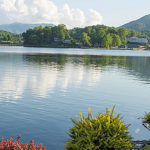Acid rain: Rain which takes nitrogen and sulphur from the atmosphere and gets acidic.
(تÛØ²Ø§Ø¨Û Ø¨Ø§Ø±Ø´)
Acre-foot: The volume of water required to cover an area of one acre of land with 12 inches of water depth. This is equal to 12,33,346 litres of water.
(اÛÚ© ÙÙ¹ Ûا اÛÚ© اÛکر Ú©Û Ø±ÙØ¨Û Ù
ÛÚº اÛÚ© ÙÙ¹ (Ø¨Ø§Ø±Û Ø§ÙÚ) Ú¯ÛØ±Û Ù¾Ø§ÙÛ Ú©Û ØجÙ
Ú©Ù ÙاپÙÛ Ú©Ø§ Ù¾ÛÙ
اÙÛ)
Aquifer: A geologic formation that holds and yields useable amounts of water.
(زÛر٠زÙ
ÛÙ Ø¢Ø¨Û Ø°Ø®Ø§Ø¦Ø±)
Brook: A natural stream of water, smaller than a river or creek.
(ÚØ´Ù
Û)
Cubic feet per second (cfs): A rate of the flow. One cfs is equal to a volume of water one foot deep and one foot wide flowing a distance of one foot in one second. One cfs is equal to approximately 1,703 litres per minute.
(بÛØªÛ Ù¾Ø§ÙÛ Ú©Û Ù¾ÛÙ
Ø§Ø¦Ø´Û Ø§ÛÚ© Ù
ÙÙ¹ Ù
ÛÚº اÛÚ© ÙÛÙ¹ ÚÙÚا Ûا اÛÚ© ÙÛÙ¹ Ú¯Ûرا پاÙÛÛ ÛÛ Ù
Ùدار3071ÙÛٹرس (ÙÛ Ù
ÙÙ¹)Ú©Û Ù
ساÙÛ ÛÙØªÛ ÛÛ)
Distillation: The separation of different substances in a solution by boiling the water and then cooling off the vapour which results in pure water. Impurities remain in the concentrated residue.
(تبخÛر اÙر پاÙÛ Ø³Û Ø¢ÙÙØ¯Ú¯Û Ú©Û Ø¯Ùر کرÙÛ Ú©Ø§Ø¹Ù
Ù)
Drainage: The natural movement of surface water over a land area to a river, lake or ocean.
(زÙ
ÛÙ Ù¾Û Ù¾Ø§ÙÛ Ú©Û Ø¨ÛÙÛ Ú©Ø§ عÙ
Ù)
Effluent: Wastewater discharged from factories or animal farms.
(کارخاÙÙÚº Ø³Û Ø®Ø§Ø±Ø¬ Ø´Ø¯Û Ú¯ÙØ¯Û Ù¾Ø§ÙÛ)
Evaporation: The process by which water is transformed to the gaseous state. (تبخÛØ±Û Ø¹Ù
Ù)
Floodplain: The land area adjacent to a river that can be covered by water when a river or stream overflows its banks.
(تاس٠سÛÙاب Ûا ÙØ¯Û Ø³Û Ù
تص٠زÙ
Û٠ج٠سÛÙØ§Ø¨Û Ù¾Ø§ÙÛ Ø³Û Ø¨Ú¾Ø± جائÛ)
Groundwater: Water present under the ground.
(زÛر زÙ
Û٠پاÙÛ)
Hardness (water): Calcium and magnesium dissolved in water. Such water leaves deposits in pipes. Hardness is often reported as ppm or milligrams per liter (mg/l) of calcium carbonate.
(پاÙÛ Ú©Ø§ Ø¨Ú¾Ø§Ø±Û Ù¾Ù)
Irrigation: The controlled application of water to crops.
(آب پاشÛ)
Lake: A considerable body of inland water or an expanded part of a river. (جھÛÙ)
Percolation: The movement of water through saturated soil layers, often continuing downward to groundwater.
(پاÙÛ Ú©Ø§ زÛر زÙ
Û٠رساؤ)
pH: A numerical measure of acidity or alkalinity. The pH scale ranges from 1 (acidic) to 14 (alkaline). A pH of 7 is neutral.
(پاÙÛ Ú©Û ØªÛزابÛت ÛاشÙرائÛت کا Ù¾ÛÙ
اÙÛ)
Pollution: Contamination of water due to human activity.
(Ø¢Ø¨Û Ø¢ÙÙدگÛ)
Potable water: Water fit for human consumption.
(Ù¾ÛÙÛ Ú©Û ÙابÙ)
Precipitation: Rain or snow falling to the ground.
(بارش Ûا Ø¨Ø±Ù Ø¨Ø§Ø±Û Ø§Ùر اس Ú©Û Ù
Ùدار)
Reservoir: Water behind a dam is called a reservoir.
(ÚÛÙ
Ú©Û Ù¾Ø´Øª پر ذخÛØ±Û Ø¢Ù¾)
Reverse osmosis (RO): A water treatment process used to remove dissolved inorganic chemicals and suspended particulate matter by passing it through a semi-permeable membrane.
(اÛÚ© جھÙÛ Ø³Û Ù¾Ø§ÙÛ Ú©Ù Ú¯Ø²Ø§Ø± کر ÙÙ
Ú© ک٠عÙاØØ¯Û Ú©Ø±ÙÛ Ú©Ø§ عÙ
Ù)
River basin: The area drained by a river and its tributaries.
(تاس٠درÛا)
Runoff: Rainwater that does not infiltrate the soil but runs off to a river or sea.
(برسÙÛ ÙاÙا پاÙÛ Ø¬Ù Ø¯Ø±Ûا Ù
ÛÚº جا Ù
ÙÛ)
Transpiration: The process of evaporation of water from plants through leaves.
(Ù¾ÙدÙÚº Ø³Û Ø¨Ø®Ø§Ø±Ø§Øª کا اخراج)
Turbidity: Water with high density of pollutants.
(Ù
ÛÙØ§Ø Ú©Ø«ÛÙ)


COMMENTS